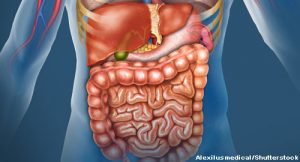 As practicing rheumatology providers, we are all too aware of the limited treatment options for gastrointestinal (GI) tract involvement in systemic sclerosis (SSc). The toll GI complications take on our patients’ lives is tangible at every visit, with symptoms ranging from refractory gastroesophageal reflux disease (GERD) to dependence on total parenteral nutrition. Patients and providers alike lament the paucity of data and therapies at our disposal for GI symptoms—especially when it comes to small and large bowel involvement.
As practicing rheumatology providers, we are all too aware of the limited treatment options for gastrointestinal (GI) tract involvement in systemic sclerosis (SSc). The toll GI complications take on our patients’ lives is tangible at every visit, with symptoms ranging from refractory gastroesophageal reflux disease (GERD) to dependence on total parenteral nutrition. Patients and providers alike lament the paucity of data and therapies at our disposal for GI symptoms—especially when it comes to small and large bowel involvement.
In the March 2022 issue of Arthritis Care & Research, McMahan et al. shed welcome light on this dark corner of rheumatic disease. The authors used nuclear imaging studies to determine whether abnormal GI transit contributes to GI severity and symptoms in SSc. In this article, we discuss their findings and implications for clinical practice with first author Zsuzsanna McMahan, MD, MHS, associate professor of medicine, Division of Rheumatology, Johns Hopkins University, Baltimore.1
Background
About 90% of people with SSc have GI tract involvement from their disease.2 Diet, microbiota dysbiosis and abnormalities in GI transit may contribute to GI symptomatology and severity.3 Researchers have not yet determined the clinical impact of abnormalities in GI transit in SSc patients. Because a variety of diagnostic tests and promotility agents are now available to treat GI dysmotility, understanding the connection between GI symptoms, their severity and abnormal GI transit may permit a targeted therapeutic approach for these patients.
Example: If an association between symptoms and severity and a specific area of abnormal GI transit can be demonstrated, the argument could be made for use of therapies that target specific bowel regions, such as octreotide primarily, which improves small bowel motility, and prucalopride, which is more active in the large bowel.4,5
Patients & Methods
McMahan et al. prospectively enrolled and studied 71 patients with SSc and GI symptoms from the Johns Hopkins Scleroderma Center, as well as 18 healthy controls. Symptoms of GI dysfunction included reflux, early satiety, nausea and vomiting, unintentional weight loss, distension, bloating, diarrhea and constipation.
All patients underwent whole gut transit scintigraphy, an objective nuclear medicine study used to assess GI transit from the esophagus to the colon. A radioisotope-labeled solid and liquid meal passes through the GI tract, and the extent and severity of transit abnormalities are quantified.
The investigators measured the presence of delayed transit and percent emptying in each region of the GI tract. These measurements were then compared with validated outcome measures used to assess GI severity and GI symptoms (i.e., the modified Medsger GI severity score, and University of California Los Angeles Scleroderma Clinical Trial Consortium Gastrointestinal Tract 2.0 [UCLA GIT 2.0] score, respectively).
